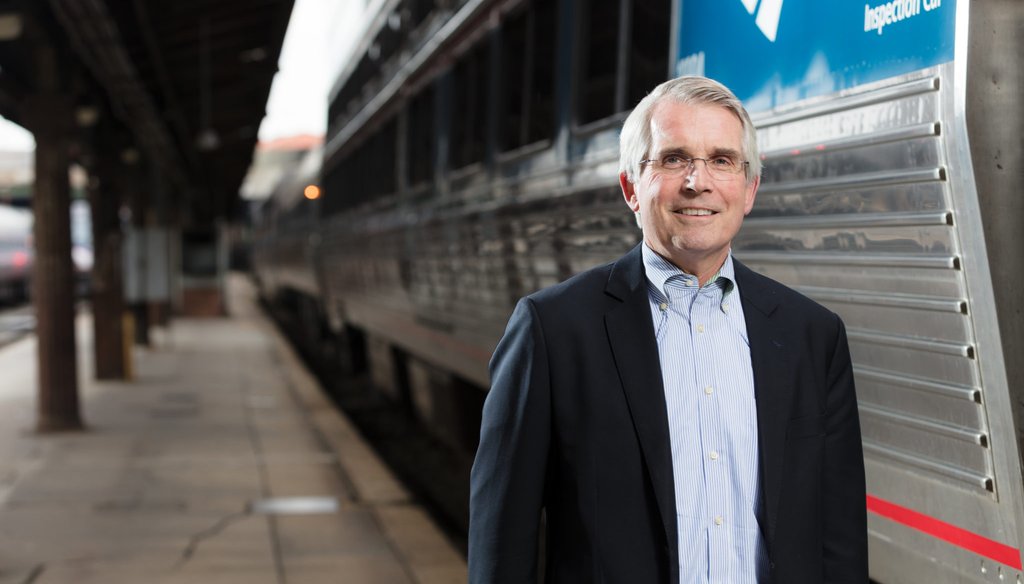

Our only agenda is to publish the truth so you can be an informed participant in democracy.
We need your help.


Wick Moorman is the CEO of Amtrak.
Amtrak CEO Wick Moorman spoke in front of a Senate subcommittee earlier this week. Per usual, he was lobbying for more federal funding for Amtrak, which operates at a loss every year and claims to need more money to service its aging infrastructure.
Philadelphia knows about the importance of Amtrak as much as any city. Not only does Amtrak have offices here, 30th Street Station is the third-busiest station in the country, and the failure of the company to implement positive train control contributed to the deadly crash of Amtrak 188 in 2015 in Frankford.
In this plea to get more funding, Moorman called on the rising need for train travel in America.
"More than ever," he said, "our nation and the traveling public rely on Amtrak for mobility."
Are we really more reliant on Amtrak than ever?
First of all, the Amtrak era began in 1971, long after the heyday of trains in the 19th century and earlier in the 20th century. During World War II, for example, nearly 10 times as many passenger miles were accumulated annually as were the last few years. But Moorman specified Amtrak, so we’ll only check from 1971 on.
And in terms of total passengers, Amtrak has never been more popular. Ridership hit a record 31.3 million in fiscal year 2016. It was 30.8 million in 2015, and since 2010 ridership has topped 30 million each year but has not increased each year.
That’s only one statistic, though. Another way to measure the frequency of travel on Amtrak is passenger miles, and the most recent data for passenger miles shows the train system trending slightly downward. For fiscal year 2016, 6.5 billion passenger miles were traveled on Amtrak. That’s one million fewer miles traveled than the previous year and two million fewer than Amtrak projected for the year — but still about one billion more than Amtrak had in 2000. Trains were also emptier than in the previous year, with a 50.9 percent average load in 2016, compared to 51.3 percent in 2015.
Another way to gauge the public’s reliance on Amtrak would be to compare its passenger miles as a percentage of overall passenger miles of similar travel options. And according to data from the U.S. Department of Transportation, Amtrak is taking up a smaller share of those miles when sized up against airline passenger miles and highway bus miles. The Congressional Budget Office has measured Amtrak against these two other forms of transportation in past reports.
In 2014, the most recent year the Department of Transportation has available for the three options, Amtrak’s passenger miles represented .7 percent of miles traveled. That’s a negligible amount lower than in 2010, but higher than in 2000. It’s lower than in 1990, when Amtrak passenger miles accounted for 1.2 percent of total passenger miles traveled across bus, air and train in the United States. There’s been a similar decline in Amtrak’s share across the same time period when you take into account all highway passenger miles and not just bus.
This would indicate that despite Amtrak’s recent growth in passengers and steady rate of passenger miles traveled per year, the service is being used for a smaller percentage of overall travel than in years past.
We asked Amtrak’s media relations team for clarification on Moorman’s comment but never heard back.
Our Ruling
In a plea for more federal funding, Amtrak CEO Wick Moorman told a Senate subcommittee, "More than ever, our nation and the traveling public rely on Amtrak for mobility."
In terms of passengers, Amtrak has never been more popular. Its ridership reached a record 31.3 million in 2016. But the train service is lagging in other ways. The number of passenger miles traveled on Amtrak in 2016 was 6.5 billion, fewer than the previous year and fewer than what Amtrak projected. Passenger miles traveled on Amtrak also represent a smaller share when compared to highway bus and air miles traveled than in the past.
We rule the claim Half True.
Press release, Amtrak, "Amtrak delivers strong FY 2016 financial results," November 17, 2016.
Press release, Amtrak, "Amtrak ridership and revenues continue strong growth in FY 2014," October 27, 2014.
Report, Congressional Budget Office, "The Past and Future of U.S. Passenger Rail Service," September 2003.
Statistics, Amtrak, Monthly Performance Report for September 2016.
Statistics, U.S. Department of Transportation, U.S. Passenger Miles.
Statistics, Amtrak, Amtrak National Facts.
In a world of wild talk and fake news, help us stand up for the facts.
